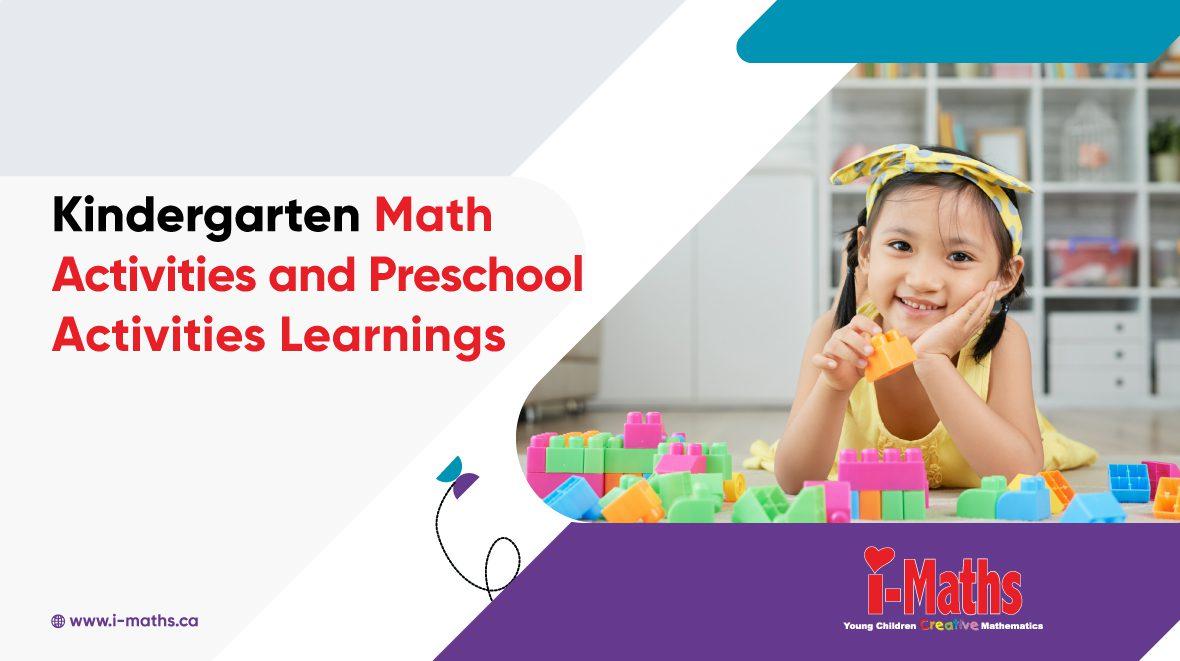Kindergarten Math Activities and Preschool Activities Learnings at i-Math
Children are like clay at an early age, they’ll easily take the shape that they are molded into. Kindergarten and preschool programs play an important role in the development of children’s brains. Learning at an early age makes the concepts deep-rooted and long-lasting. Here, math works best! It not only helps children in solving mathematical problems but also aims to enhance other skills like observation, logical thinking, reasoning, analysis, and synthesis.
Number recognition and counting are the first and most important things in the kindergartener’s and preschool math skills checklist. To hit their math goals, a child must first learn to recognize and count numbers. Kindergarten and preschool math skills include building a foundation for mathematical concepts and basic numeracy. Some of the math skills taught are counting, number recognition, number formulation, basic addition and subtraction, patterns, shapes and geometry, measurement, data analysis, along with time and money.
Kindergarten often focuses on teaching children to count from 1 to 10 and beyond. They learn to count objects, fingers, and numbers on a number line. Children learn about different shapes such as circles, squares, triangles, and rectangles. They learn to identify and sort shapes based on their attributes. They learn to sort objects based on various attributes like color, shape, size, and type and develop skills in categorization and classification.
While preschool focuses on children learning to recognize and identify numbers, both numerals and written words. They start to associate a numerical symbol with its corresponding quantity. Children also get to learn basic operations such as addition and subtraction and begin to understand the concepts of combining sets (addition) and taking away from sets (subtraction). They explore and create patterns, which helps develop their logical thinking and recognition of recurring sequences. Basic measurement concepts are introduced, such as comparing sizes, lengths, and weights.
These skills are taught through hands-on activities, games, songs, and interactive experiences to make learning math engaging and enjoyable for young children.
It provides children with an ideal platform to learn by systematically guiding them through various modes of learning such as Sensorial, Kinesthetic and Visual.
Sensorial Learning
Sensorial learning, also known as sensory learning or experiential learning, is an approach to learning that emphasizes the use of the senses to enhance the learning process. This learning mode recognizes that children learn best when they engage multiple senses, such as sight, hearing, touch, taste, and smell, to gather information and make sense of the world around them. Our learning environment is designed to provide opportunities for sensory exploration and discovery. It involves hands-on experiences, experiments, and activities that stimulate the senses and encourage active participation. By engaging the senses, children can develop a deeper understanding of concepts, improve memory retention, and enhance overall learning outcomes.
Kinesthetic Learning
Kinesthetic learning, also known as tactile learning or hands-on learning, is a learning mode that emphasizes physical activities and movement as a primary means of understanding and retaining information. In kinesthetic learning, children rely on physical experiences and actions to process information and make connections. They often benefit from activities that involve manipulating objects, performing experiments, participating in role-plays, or engaging in physical exercises. By actively engaging their bodies, children can better internalize and understand concepts, improve their muscle memory, and enhance overall learning outcomes.
Visual Learning
Visual learning is an approach to learning that emphasizes the use of visual aids and stimuli to understand and retain information. Children who prefer visual learning tend to learn best when they can see and observe information in a visual format, such as diagrams, charts, graphs, images, videos, or written text. In the visual learning approach, visual stimuli are used to present information, concepts, and ideas. Children benefit from seeing the relationships between different elements, identifying patterns, and creating mental images. These children often have a strong visual memory and recall information more effectively when it is presented visually.
By engaging in these problem-solving activities, children learn to break down complex problems into manageable parts, apply logical reasoning to find solutions and develop perseverance and resilience in the face of challenges. Here, an early-age math program helps enhance skills like observation, logical thinking, and reasoning by providing a structured framework for children to engage with mathematical concepts and develop their cognitive abilities. These skills have wide-ranging applications beyond mathematics and are crucial for academic success and lifelong learning.
Children are prepared in the areas of problem-solving, connection, patterns & relationships, and number awareness at i-Math. We nurture a child’s critical & creative thinking ability through math for kids’ concepts. So if you are looking for the best math early learning program that focuses on kindergarten as well as preschool activities and goals, i-Math Canada provides children an ideal platform to learn by systematically guiding them through various modes of learning such as Sensorial, Kinesthetic, and Visual. It inspires critical and creative thinking in them.

